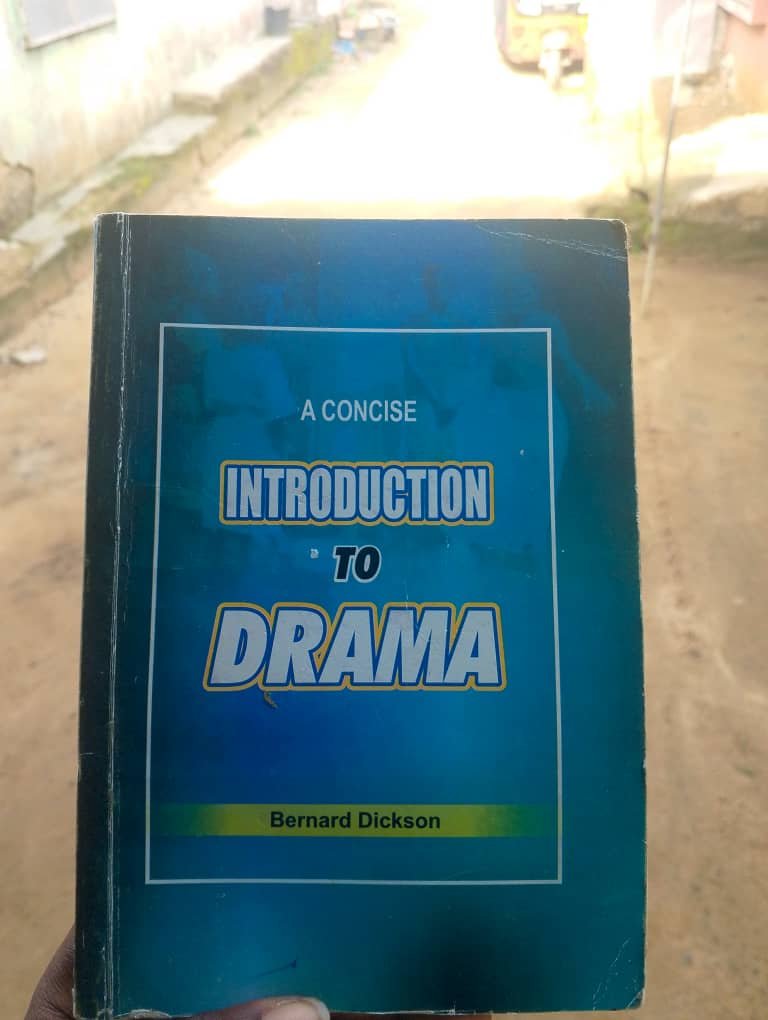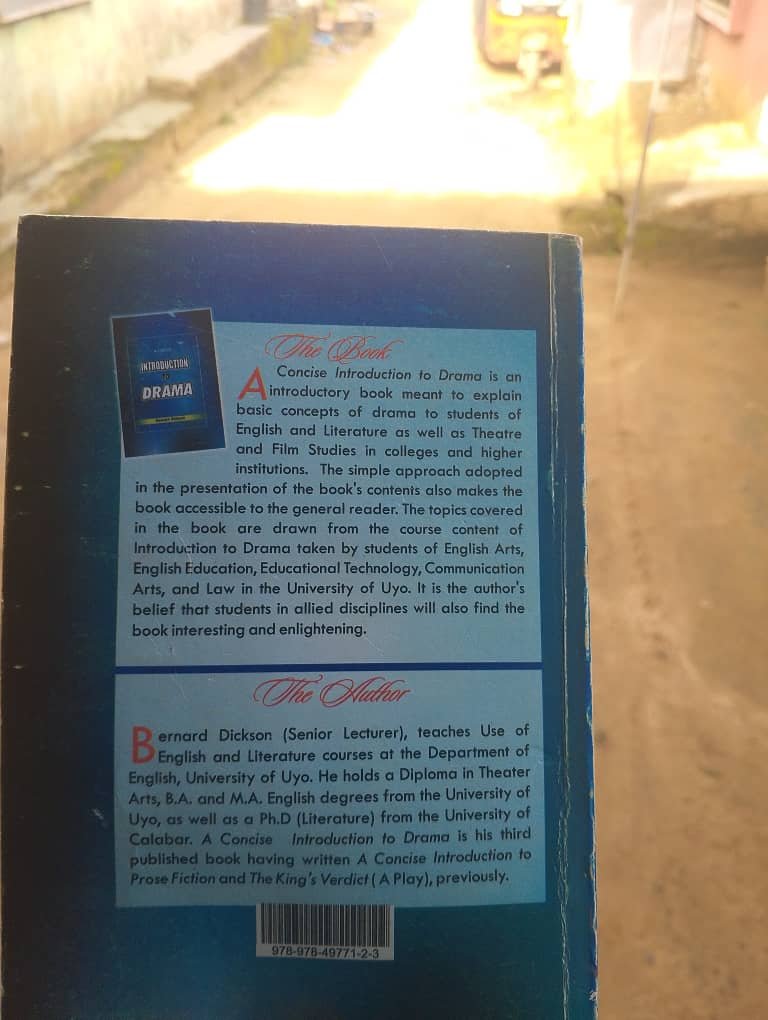El Concepto de Drama y Sus Elementos (ENG ESP) Drama and it's concept.
A review of Introduction to Drama by Dr Bernard Dickinson of the University of Uyo
Drama is one of the oldest and most expressive forms of art known to mankind. It brings together language, movement, emotion and human experience in a way that no other genre quite captures. In the midst of many textbooks that attempt to explore this subject, Introduction to Drama by Dr Bernard Dickinson, a sound and highly respected lecturer at the University of Uyo, stands out as a clear and accessible guide to understanding the world of drama. As someone who has had the opportunity to go through the book, I can say that it is not just another academic material. It feels like sitting down with a wise teacher who knows how to explain complex ideas in a very simple and engaging manner.
Dr Bernard Dickinson, known for his sharp intellect and love for the dramatic arts, pours his years of teaching and research into this work. He does not just define drama in the usual academic way. Instead, he takes the reader on a journey into its roots, its structure, its purpose and its relevance to society. He starts by helping us understand what drama really is. He explains that drama is not just acting or performance but a reflection of life. It is about conflict, dialogue, and movement through which characters come alive and tell stories that connect to human emotions and real life struggles.
One of the beautiful things about this book is that it breaks down technical terms and theories without sounding too complicated or boring. Students from any department, not just Theatre Arts, can pick it up and find it easy to understand. Dr Dickinson uses examples from both classical and modern plays to make his points. From the works of Sophocles and Shakespeare to African playwrights like Wole Soyinka and Ola Rotimi, the book paints a broad and rich picture of drama across time and cultures.
Another strength of the book is its emphasis on African contributions to drama. Many introductory drama texts focus only on European traditions, but Dr Dickinson makes sure to shine a light on the importance of African performance styles, storytelling traditions and oral history. This not only makes the book more relevant to Nigerian students, but it also restores a sense of pride in our cultural heritage. He draws attention to how drama in Africa often served as a communal event used for education, spiritual purposes and conflict resolution, even before the advent of Western theatre.
The book also covers the basic elements of drama such as plot, character, setting, dialogue, theme and spectacle. Each of these elements is treated with care and explained using real examples. Dr Dickinson does not only explain what they are but also shows how they work together to make a play successful. He also touches on different types of drama including tragedy, comedy, tragicomedy and satire. By the end of the book, the reader is equipped with the tools to not only understand drama but also to analyze and even create dramatic works.
Another area the book excels in is the way it connects drama to everyday life. It reminds us that drama is not something foreign or distant. It happens around us every day. When people argue, celebrate, mourn, or even pretend, they are performing a kind of drama. This approach makes the subject more relatable and less intimidating to new students.
In summary, Introduction to Drama by Dr Bernard Dickinson is more than a textbook. It is a sincere and intelligent conversation between a teacher and his students. It brings life to the subject of drama and opens the door for anyone interested in the art of storytelling and performance. Whether you are a Theatre Arts student, a literature lover, or someone just curious about drama, this book offers a solid foundation. It is also a reminder that African scholars like Dr Dickinson are contributing meaningfully to academic discourse and deserve to be read and appreciated.



Introducción al Drama por el Dr Bernard Dickinson de la Universidad de Uyo
El drama es una de las formas más antiguas y poderosas de expresión artística. A lo largo de la historia, ha sido utilizado para comunicar emociones, contar historias y explorar conflictos humanos. En medio de muchos libros que intentan explicar esta disciplina, el libro Introducción al Drama del Dr Bernard Dickinson, un profesor sabio y muy respetado de la Universidad de Uyo, se destaca como una obra clara, educativa y cercana. No se trata solamente de un material académico, sino de una guía que se siente como una conversación con un maestro que conoce profundamente su tema.
El Dr Dickinson no se limita a definir el drama con palabras técnicas. Más bien, invita al lector a entender el drama como un espejo de la vida real. Según él, el drama es más que actuación. Es conflicto, emoción y diálogo. Es un camino a través del cual los personajes representan nuestras propias luchas y experiencias humanas. Esta visión hace que el libro sea accesible y significativo incluso para quienes no son estudiantes de teatro.
Una de las cosas más valiosas del libro es la manera en que explica los términos y conceptos básicos. Con un lenguaje sencillo y ejemplos claros, el Dr Dickinson guía al lector a través de los elementos esenciales del drama como el argumento, los personajes, el espacio escénico, el diálogo, los temas y la acción. Usa ejemplos tanto de obras clásicas como modernas. Desde Sófocles y Shakespeare hasta Wole Soyinka y Ola Rotimi, el texto ofrece una visión amplia de la evolución del drama en diferentes culturas.
Lo que hace especial a este libro es su enfoque en las tradiciones africanas. Mientras muchos textos sobre drama se centran únicamente en el teatro europeo, el Dr Dickinson da un lugar importante a la contribución africana. Habla sobre la narración oral, las representaciones tradicionales y los rituales que han formado parte del teatro africano durante siglos. Esto no solo enriquece la perspectiva del lector, sino que también fortalece el valor de nuestra identidad cultural.
El libro también enseña sobre los tipos de drama como la tragedia, la comedia, la tragicomedia y la sátira. Cada uno de estos géneros es explicado con ejemplos claros y relevantes. Además, se muestra cómo los elementos dramáticos trabajan en conjunto para lograr un impacto emocional y artístico en el espectador.
Lo que más se aprecia es cómo el autor conecta el drama con la vida cotidiana. Nos recuerda que el drama no es solo lo que ocurre en un escenario. Está presente en nuestras vidas todos los días. Cuando discutimos, contamos historias, actuamos con emoción o simplemente expresamos sentimientos, estamos participando en una forma de drama. Esta idea hace que el tema se sienta más cercano, más real y menos abstracto.
En conclusión, Introducción al Drama del Dr Bernard Dickinson no es solo un libro académico. Es una obra apasionada escrita por un verdadero amante del arte dramático. Es educativa, inspiradora y profundamente humana. Para estudiantes, profesores o cualquier persona interesada en el teatro, este libro ofrece una base sólida. También es un testimonio del valor de los académicos africanos en el mundo del conocimiento. Un libro como este merece ser leído, compartido y celebrado.